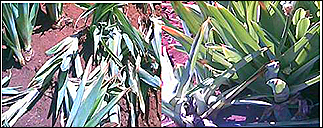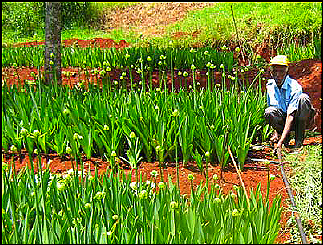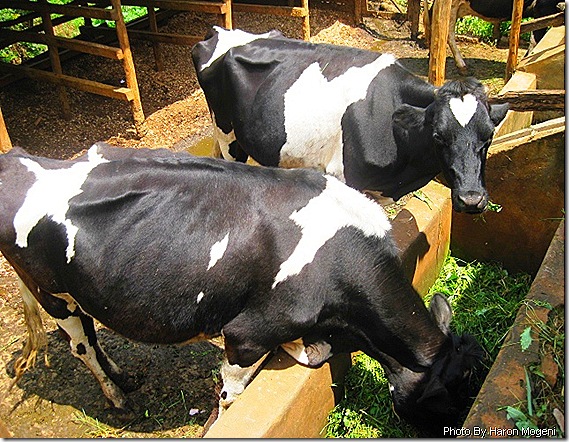 Temperature is very vital for the flowering of Alstroemeria; therefore, it has been established that altitudes of 1800 m to 3000 m above sea level are ideal for its growing in the tropics.
Temperature is very vital for the flowering of Alstroemeria; therefore, it has been established that altitudes of 1800 m to 3000 m above sea level are ideal for its growing in the tropics.
The absolute temperature requirement for flower induction of 10 to 160 C is only achievable in the aforesaid altitudes; temperatures above 250 C hinder flower initiation, and lead to the production of non flowering shoots.
This utter temperature requirement restricts the area where Alstroemeria can be grown profitably. Alstroemeria plants thrive best in areas with temperature ranges of 10 to 200C.
After the plants have been induced to flower, the environmental temperature and light conditions control the rate of shoot and flower development.
A return to the vegetative stage can occur if the temperatures get high. The plants need to be protected from wind, which leads to lodging of tall plants.
SUITABLE SOILS
Soils should be rich, well drained and contain high organic matter. The ideal soil PH is 6.5. Plants can acclimatize to a wide variety of soils provided the soils are deep and well drained.
In areas where of soils are high in aluminum and manganese, it may be necessary to apply agricultural lime at the rate of 5 tons /Ha to prevent chlorosis and leaf tip burn. It is important to analyze the soil regularly.
High soil temperatures can be reduced by using overhead irrigation, mulching or a good plant cover.
Suitable areas for growing Alstroemeria in Kenya include Limuru, Kericho, Kaptagat, Wundanyi, Timboroa, Molo and Meru but it can be grown in much warmer area but under shade netting.
SUITABLE CULTURAL PRACTICES FOR ALSTROEMERIA
Planting should be done in April/ May to produce export flowers by September or October. The land should be well prepared and should include 20 to 30 tons of manure. Make raised beds of 1 meter and incorporate 500 kg/ha of TSP.
PROPAGATION OF ALSTROEMERIA
Most of the present day Alstroemeria varieties are sterile hybrids hence propagation through vegetative means however the plant can be propagated through seeds by plant breeders.
The most common method of propagation is by division of underground rhizomes that have attached roots (splits).
The propagation rhizomes are obtained from 2-3 year old plants, meristem cuttings are used in developed countries.
Before planting, it is necessary to dip the rhizome in a fungicide solution to prevent its rotting. Thereafter, plant the rhizome at a depth of 10-15 cm.
The soil can also be drenched with a fungicide if the rhizomes were hot treated before planting.
SPACING IN ALSTROEMERIA
Alstroemeria is grown on a one meter wide bed with 50 cm paths. Each bed contains 2 rows of plants with 35 to 40 cm between rows and 40 to 50 cm between plants.
FERTILIZER APPLICATION IN ALSTROEMERIA
Alstroemeria is a heavy feeder that requires a lot of nitrogen and potassium. Plants grown in soils with low levels of nitrogen produce flowers with poor keeping quality.
Nitrate forms of fertilizers have the nitrogen more available to the plant than ammonium forms for the cooler areas where Alstroemeria is grown.
Plants with low potassium content tend to have fragile and tender stems. After six months of plant growth, apply potassium as a top dressing.
For a new plantation, apply nitrogen, phosphorus, potassium 20-10-10 or 17-17-17 and calcium ammonium nitrate in the ratio of 1:1 at the rate of 2 kg /100 meter of the bed length every two weeks.
Applying Nitrogen at the time of planting helps to increase the level if cytokinins in the plant which promotes chlorophyll development.
This helps to delay leaf yellowing which is a common problem with Alstroemeria flowers.
THINNING OF ALSTROEMERIA
It is performed to reduce the competition of water, nutrients and to open the plants up. Weak and non flowering shoots are pulled out the shoots.
Pulling is a healthier practice as it reduces crowding in the bed, although care should be taken not to uproot the rhizome.
MALE SHOOTS IN ALSTROEMERIA
The male shoots tend to lean on the female shoots. The male shoots can be distinguished in that they have an opened head tip while that of the female is cone shaped at the point where the flower bud emerges.
The male shoots have large leaves and shorter stalks (stems) compared to the female shoots. Too much thinning of the male flowers should be avoided as they act as a shade for the female shoots; also excess thinning tends to induce early flower opening.
Male shoots have an advantage in that they help to store carbohydrates in the rhizomes for use by the female shoot.
SUPPORT FOR ALSTROEMERIA
For high quality plants, Alstroemeria stems need a good support system. This is achieved by using either a net support system or a simple wire or twine system.
When using a net support system, it is necessary to place the net in position when planting. Two or four layers of support are necessary depending on the variety grown.
The first one should have a height of 25cm; the others should have a height of 60, 90, and 125 cm. The squares should be approximately 12.5x12.5 cm for all the other layers.
IRRIGATION PROGRAM FOR ALSTROEMERIA
It requires a lot of water because of their nature of roots and its bushy growth. Overhead irrigation can be used till flowering commences to prevent damage to flower.
Irrigation can be done in the evening to prevent high water loss due to evaporation during the day.
Overwatering normally results in yellowing of the leaves. Continuous overhead irrigation can lead to the incidence of leaf spot diseases.
WEED CONTROL IN ALSTROEMERIA
In the field should be kept weed free. Shallow cultivation is encouraged so as not to disturb the root system.
MATURITY, HARVESTING AND POST HARVEST HANDLING OF ALSTROEMERIA
Harvesting starts 4 to 6 months from planting. Good yields are achieved in the fifth and sixth months.
The best quality cut flowers are those with long and straight stems. The cut stages will depend on the market and cultivar.
Flowers are cut when the first flower is just about to open or the beginning of the tight stage for export, but for direct sales or local market can be harvested by pulling them at the base.
The whitish part of the stem is then cut off and the flower is dipped in the bucket with water to prevent drying and then carefully transported to the pack house.
YIELD OF ALSTROEMERIA
Expected yields can be 180-300 stems per M2 per season.
GRADING OF ALSTROEMERIA
The flowers are sorted and graded immediately after harvest. Grading parameters to be observed after harvest are wholesomeness, stem length, stem strength, straightness uniformity, and symmetrical flower head with 7 to 10 florets.
Depending on the cultivar and bright green leaves. Grading by stem length
Grade I 80 cm
Grade II 70 cm
Grade III 60 cm
The graded cut flowers are then bunched into tens or twenty’s depending on the market, wrapped with either paper or plastic.
CHEMICAL TREATMENTS OF ALSTROEMERIA AFTER HARVESTING
Leaf yellowing in Alstroemeria can be delayed by use of chemical preservatives with plant growth hormones such as Florissant 100 or 200 and crystal.
Florissant 100 contains silver thiosufate which inhibits ethylene production by the flower, thus increasing vase life, whereas Florissant 200 contains plant hormones which prevent yellowing.
PACKING OF ALSTROEMERIA
The sleeved bunches are packed in ventilated carton boxes. The number of stems is determined by the length of the stems and the market requirements.
Flower heads are placed on both ends of box for better use of space. The heads of the flowers should be placed 7-12 cm from the end of the box to avoid the petals from being bruised.
The flowers should be packed firmly in boxes in such a way that transport damage is minimized.
PRE COOLING OF ALSTROEMERIA
Forced air cooling is used to bring down the temperature of the flowers to 2 to 40C and to remove the field heat.
Cool air is blown through the boxes and the warm air is sucked out through the ventilation holes.
STORAGE OF ALSTROEMERIA
The packed flowers can then be kept in a cold room at the same temperature of 2-40 C and a relative humidity of 90 to 95% prior to being transported to the airport.
DISEASES AND PESTS OF ALSTROEMERIA
There are two diseases that affect Alstroemeria in Kenya
Root rot- this disease is caused by Rhizoctonia sp which affects the stem first, then the roots. The fungus clogs the stem which eventually dies due to reduced nutrient uptake.
Control is through the use certified planting material and dipping the rhizomes in fungicides solutions before planting.
Damping off-Caused by pythium sp
This disease affects juvenile or succulent tissues. The roots of the plants turn waxy and rot. This is the most common diseases affecting the seedlings of a very wide host range.
Stems become very weak and have lesions at the soil level and leaves start rotting. Control sterilization of soil media and spraying benomyl or thiophanate methyl at 0.2%
Botrytis grey mold-Symptoms appear on the flower and buds spots turn brown and fungal growth forms on the leaves. Control use of Ravral or Bavistin; or Fumigate with chlorothamomil
PESTS
The common pests affecting Alstroemeria are aphids, caterpillars, mites and fussy flies, nematodes.
Control
For caterpillars and fussy flower spray Rogor E. Pyrethroids and miticides are effective against aphids and mites. Use nemacure every 3 months as control against nematodes.
 This annual flower is gaining popularity among small scale farmers because they are easy to grow, they yield higher returns to farmers. Thus many Non governmental organizations are promoting the cultivation of this flower on their poverty eradication efforts with great success.
This annual flower is gaining popularity among small scale farmers because they are easy to grow, they yield higher returns to farmers. Thus many Non governmental organizations are promoting the cultivation of this flower on their poverty eradication efforts with great success.

![clip_image001[1] clip_image001[1]](https://blogger.googleusercontent.com/img/b/R29vZ2xl/AVvXsEikO5ZjuWwj4i1lVZ_niG7Qu_ZyL_mu5JmjkOx2arQRT5sXd2pIrXr-X3lVS7hHGWCC9wwO9ixI1DZF5nxqB6Xbzmg4yeFslfZu1tOaE5RoV18Fo-jxT3n3v4gwbTKapTkJL2TmaEOtbqQ/?imgmax=800)










